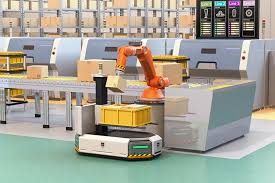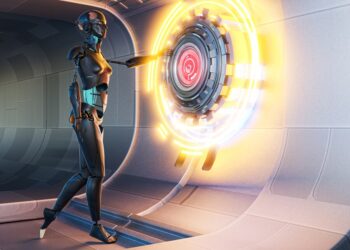How Industrial Robots are Revolutionizing the Manufacturing Industry
As technology continues to advance, so too do the capabilities of industrial robots. From increased precision to enhanced speed, the latest advancements in robotics are changing the face of manufacturing, and with it, the way we live our lives.
The use of industrial robots in manufacturing has been growing for decades, and their benefits are clear. Robots can work 24/7, with precision and consistency that is difficult for humans to match. They also eliminate the risks associated with manual labour, such as injury and fatigue, and can operate in environments that are hazardous to human workers.
The latest advancements in industrial robots are taking these benefits to a whole new level. Here are just a few of the ways that industrial robots are revolutionising the manufacturing industry:
Increased Flexibility
One of the biggest advancements in industrial robots is their increased flexibility. Robots are no longer confined to performing a single task or function. Instead, they can be programmed to carry out a variety of tasks, making them ideal for use in a range of industries.
For example, industrial robots can be programmed to carry out assembly tasks, such as screwing in bolts or welding pieces together. They can also be programmed to carry out inspection tasks, such as checking the quality of products as they move along a production line.
This increased flexibility is due to advancements in software and hardware technology. Modern industrial robots are equipped with advanced sensors and software that allow them to adapt to changes in their environment and respond to different situations.

Collaborative Robots
Another major advancement in industrial robots is the development of collaborative robots, or “cobots”. These robots are designed to work alongside human workers, sharing the same workspace and performing tasks that require a combination of human dexterity and robot precision.
Cobots are becoming increasingly popular in industries such as automotive manufacturing, where they can work alongside human workers to carry out tasks such as installing windshields or painting cars. They can also be used in industries such as food production, where they can work alongside human workers to carry out tasks such as packing and sorting.
Cobots are designed to be safe to work alongside humans, with features such as force-limiting technology that prevents them from causing injury if they come into contact with a human worker. They also have sensors and cameras that allow them to detect the presence of humans and adjust their behavior accordingly.
Artificial Intelligence and Machine Learning
Advancements in artificial intelligence (AI) and machine learning are also playing a major role in the development of industrial robots. These technologies are enabling robots to learn and adapt to their environment, making them more intelligent and autonomous.
For example, industrial robots can be programmed to learn from their mistakes, so that they can improve their performance over time. They can also be programmed to learn from human workers, so that they can perform tasks in a more human-like way.
Machine learning algorithms are also being used to help industrial robots identify defects in products. By analyzing large amounts of data, robots can learn to detect defects in products, such as scratches or dents, with a high degree of accuracy. This means that they can identify and reject faulty products before they reach the end customer, reducing waste and improving quality control.
Advanced Sensing and Vision Systems
Advancements in sensing and vision systems are also making industrial robots more versatile and effective. Robots can now be equipped with advanced sensors and cameras that allow them to see and feel their environment in a way that is similar to human perception.
For example, robots can be equipped with 3D vision systems that allow them to detect the shape and position of objects in their environment. This makes them ideal for tasks such as picking and placing objects, where they need to be able to locate and grasp objects with precision.
Robots can also be equipped with tactile sensors, which allow them to feel and manipulate objects with a similar level of sensitivity to human touch. This makes them ideal for tasks such as sorting and packaging products, where they need to be able to handle delicate or fragile objects without damaging them.
Mobile Robots
Another area of advancement in industrial robots is the development of mobile robots. These robots are designed to move around and navigate their environment autonomously, without the need for fixed infrastructure such as conveyor belts or assembly lines.
Mobile robots are ideal for use in industries such as logistics and warehousing, where they can be used to transport goods and materials around a facility. They can also be used in industries such as agriculture, where they can be used to harvest crops or perform other tasks that require mobility.
Mobile robots are equipped with advanced sensors and mapping technology that allow them to navigate their environment with a high degree of accuracy. They can also be programmed to avoid obstacles and navigate around people and other objects in their environment.
The Future of Industrial Robotics
The advancements in industrial robots are only the beginning. As technology continues to advance, we can expect to see even more sophisticated robots that are capable of performing a wider range of tasks with greater precision and autonomy.
One area of development is in the use of swarm robotics, where groups of robots work together to perform tasks in a coordinated way. This approach could be used to carry out tasks such as search and rescue operations or cleaning tasks in large facilities.
Another area of development is in the use of soft robots, which are made from flexible materials that allow them to move and adapt to their environment in a way that is similar to biological organisms. Soft robots could be used in a range of applications, such as medical devices or environmental monitoring.

Conclusion
The advancements in industrial robots are transforming the manufacturing industry, making it more efficient, safer and more flexible. With the continued development of technologies such as AI, machine learning and advanced sensing systems, we can expect to see even more sophisticated robots that are capable of performing increasingly complex tasks with greater autonomy.
While some may fear that robots will replace human workers, the reality is that robots are helping to create new jobs and opportunities in industries such as robotics engineering and programming. As we continue to embrace the advancements in industrial robotics, we can look forward to a future where humans and robots work together to create a better world.
















